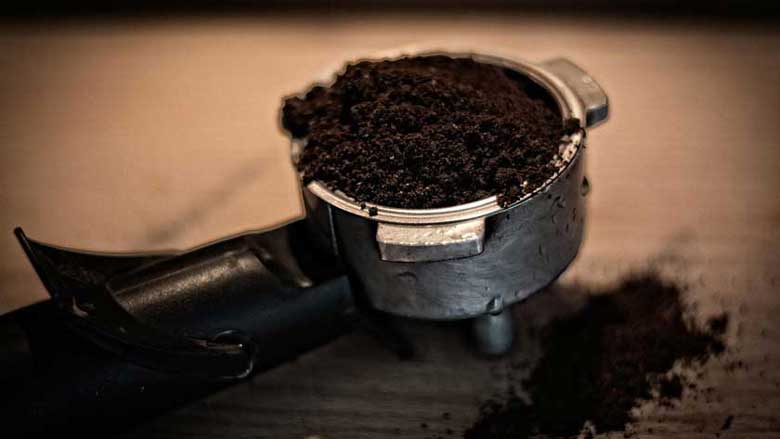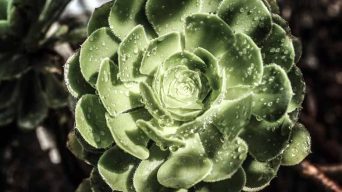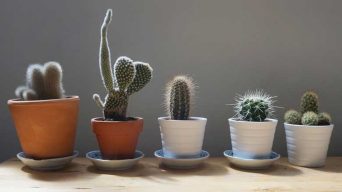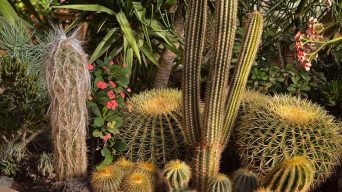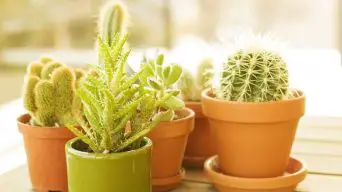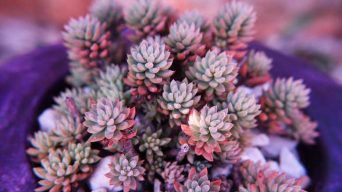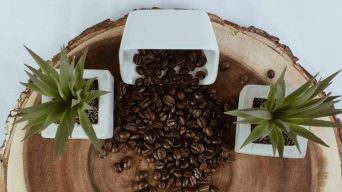Succulents and cactus plants are a popular addition to any garden. Still, many people have questions about how best to care for them.
Many people have heard that coffee grounds are good for plants. There are many benefits that coffee grounds have for plants, such as aiding the growth of ferns and petunias.
But are coffee grounds good for succulents and cacti?
Coffee grounds can be good for succulents and cactus plants. They improve the quality of soil and provide an abundance of nutrients such as nitrogen, phosphorus, and potassium, which are essential to succulents. They can also help keep certain pests away from the succulents.
All this is true. But there’s a catch: coffee grounds need to be used in the right way and with care.
Using Coffee Grounds as Fertilizer
Coffee grounds are popular as an organic fertilizer because of their high nutrient content.
They have been used as a natural fertilizer for centuries. The acidity and nitrogen in the beans make them a perfect nutrient-rich soil additive.
They provide plants with essential minerals like potassium to help their roots grow strong while suppressing weeds that compete with your garden’s growth.
They also help improve the soil’s pH by buffering it.
This is because coffee grounds are slightly acidic. They release nitrogen into the air as a gas that acts as an ingredient for plant growth and improving drainage.
Are Coffee Grounds Always Good For Succulents?
Some plants do not benefit from coffee grounds, while others do.
But do succulents like coffee grounds? Are coffee grounds good for succulents?
Well, it all depends on what soil your succulent is planted in.
Suppose you are growing succulents in a cactus mix like sand or clay. In that case, adding fresh coffee grounds to the surface will provide ideal nourishment.
It could even help keep certain pests away from them.
On the other hand, if you are growing your succulent in a soil-based mix, adding coffee grounds is not recommended.
The reason for this is that the acidity levels of these two types of soils can vary to a great degree, and it’s essential to match them up accordingly when fertilizing succulents.
When the pH level differs too much from what they’re accustomed to, they could experience nutrient deficiencies or burn due to abundant nutrients.
For example, if the cactus soil has a higher clay content than usual, red brick dust is mixed into it. Watering with fresh coffee grounds will help buffer those high clay levels while providing all the necessary nourishment the plant needs.
On the other hand, soil mixes like peat moss have lower pH values, and adding coffee grounds may cause the soil to be too acidic.
Benefits of Using Coffee Grounds to Fertilize Succulents
There are many benefits to using coffee grounds for succulents.
It can increase nutrients, a buffer against acidic soil. It may even help the soil retain moisture better than without this addition.
Overall, adding some coffee grounds will not hurt your plants. Ensure you match their pH levels appropriately and follow the basic rules when fertilizing your plants.
The following are some benefits coffee grounds can have for succulents.
Improves Soil Quality
Adding coffee grounds to your succulents’ soil can help improve its quality.
The grounds add nutrients and nitrogen in a time-released form that will not burn as a chemical fertilizer may.
They also provide an appropriate pH level for healthy plants, which many people find difficult to maintain with most store-bought fertilizers.
As such, adding this ground material helps keep the soil moist longer.
Attract Beneficial Microbes
Coffee grounds are also known to attract beneficial microbes, which can help your succulents stay healthy.
The problem is that not all the bacteria and other microscopic organisms in there are good for them.
Any coffee ground compost you create must be mixed with a nitrogen-rich material like straw or leaves. This ensures that it doesn’t kill off some helpful bugs while attracting others.
Helps Control Soil Contamination
It’s also worth noting that coffee grounds can help control soil contamination in the pot.
Since they can fight off some of the fungi that cause root rot, using them in your succulent’s soil mix will help keep it cleaner and healthier for longer.
But to do this, you’ll need to ensure the coffee grounds are mixed into wet soil before putting any water on top.
Soaking dry grounds in water could cause a chemical reaction that introduces toxins instead of getting rid of them as intended.
Can Act as a Natural Pesticide
Coffee grounds work as a natural pesticide.
When you add coffee grounds to your soil mix, it helps prevent slugs and snails from eating away at it or getting into the dirt.
Coffee contains caffeine, which deters many insects that feed on vegetation, such as weeds and other plants because they find its smell distasteful.
The best thing about this defense system against unwanted guests is that you don’t have to worry about chemicals messing with soil quality.
How To Use Coffee Grounds to Fertilize Succulents
There are three ways to use coffee grounds to fertilize succulents:
- Using them to compost
- Using them as liquid coffee
- Adding the coffee grounds to the potting mix
Using Coffee Grounds To Make Compost
Coffee grounds contain nitrogen and potassium, two of the most important elements for plant growth.
When you add coffee grounds to your compost pile, it becomes rich in these nutrients that plants need so much during their growing stages.
You can also add other ingredients like eggshells or banana peels to experiment with different ingredients.
Besides this, adding coffee grounds to your compost pile will help keep it moist, aerated and help keep pests away.
The best thing about using this type of fertilizer is that it doesn’t come with any toxic chemicals or anything harmful like other types of fertilizers often do.
Another benefit is how easy it is to use: take some old coffee grinds out from your morning cup and dump them into a container full of soil.
Using Liquid Coffee
The liquid from coffee grounds is also a good fertilizer for succulents and other types of plants.
It has all the nutrients that they need during their growing stages, like nitrogen, phosphorus, potassium, etc., which are essential for healthy plant growth.
The best type of liquid coffee to use for fertilizer is the ones that are cold-brewed because these have a higher level of caffeine.
You can also use coffee grounds in liquid form for fertilizing plants by adding them to water and letting them seep through roots before watering again.
A little bit of liquid coffee goes a long way. Mix it with water and apply it to your succulent soil.
Adding Coffee Grounds to the Succulent Potting Mix
If you already have succulents growing in your potting mix, adding coffee grounds to the soil is a good idea.
But if not, it’s better to gradually get them accustomed to their new environment by mixing them with other materials like sand and pebbles before introducing coffee grounds into the equation.
The best time to do this is when transplanting or re-potting your plants during springtime. Giving them some fresh nutrients will help make their flowers more colorful and fragrant.
Just mix a tablespoon of finely ground coffee with the soil before potting.
Disadvantages of Using Coffee Grounds as Fertilizer
There are a few disadvantages to using coffee grounds as fertilizer.
- Coffee grounds may cause increased moisture retention, leading to root rot or other fungal diseases if not monitored carefully.
- Fungal growth, specifically mold, can also be increased using coffee grounds as fertilizer.
- Coffee grounds are acidic and will alter the soil pH levels, affecting other plants in your garden that prefer a more neutral environment.
- Coffee grounds also have a high salt content, leading to other problems, such as root burn if plants are watered too often.
- Coffee grounds may cause nutrient deficiencies if not mixed correctly.
- Coffee grounds can inhibit plant growth because of the high caffeine content.
Tips on Using Coffee Grounds for Succulents
There are a few things to consider when using coffee grounds as succulent fertilizer.
Introduce Coffee Grounds Slowly to the Succulent Mix
When using coffee grounds as succulent fertilizer, it’s essential to introduce them slowly into your garden mix because of how acidic they are.
This means you should start with sand and pebbles before mixing in some coffee grounds for a better absorption rate for all the nutrients found within this organic material.
Mixing too much at once can cause an overload on your plants’ systems. Do it gradually over time instead of dumping everything on top of their roots.
Make Sure Your Succulents Have Enough Drainage and Aeration
If you would like to try using coffee grounds for fertilizer, be sure that there is plenty of drainage.
Drainage helps the roots not sit in water and allows your plant’s soil pH levels to stay neutral.
Mix the coffee grounds with sand or perlite to improve drainage and aeration.
Be Careful Not to Overwater
It would help if you watered your succulents less often when using coffee grounds.
They have a lower water retention rate than regular potting soil.
Use Only Cold Black Coffee Grounds
If you want to use liquid coffee as a fertilizer, make sure it’s cold black coffee.
Hot or warm coffee can burn your plants. Also, make sure that it is only coffee and does not have sugar, cream, or milk in it.
Take Into Account the Type of Soil You Use
It is crucial to consider the soil type you use when using coffee grounds as fertilizer.
Use a cactus and succulent potting mix if you are fertilizing these plants.
Succulents That Thrive on Coffee Grounds
Some of the most common succulents that benefit from coffee grounds are:
Snake Plant (Sansevieria)
The Sansevieria is a popular ornamental plant that has beautiful and long-lasting leaves.
This versatile houseplant can be found in many homes worldwide because of its ability to thrive under low-light conditions, drought tolerance, and clean air benefits.
Jade Plant (Crassula Ovata)
The Jade Plant is a flowering succulent that its long, pointed leaves can identify.
It gets its name from the green plant with white or light-gray stripes on older plants and is typically shaped in an upright columnar shape.
They are great for indoors as they do not need much sunlight to thrive.
Christmas Cactus (Schlumbergera)
The Schlumbergera, commonly known as Christmas Cactus, is a beautiful flowering plant that prefers to spend the winter in areas with mild temps.
One of its more recognized features is the bright red flowers it produces during Christmastime.
Final Thoughts
Coffee grounds can be good for succulents.
They improve soil quality and provide abundant nutrients, such as nitrogen, phosphorus, and potassium, essential to succulent plants.
Besides this, they help keep pests away from these plants.
However, coffee grounds are good for succulents only when used correctly and carefully.
When not using too much at a time (such as more than once every two weeks), coffee grounds can make an excellent fertilizer for succulents!
Because of this, I suggest using coffee grounds as a fertilizer for your succulents occasionally rather than daily.

